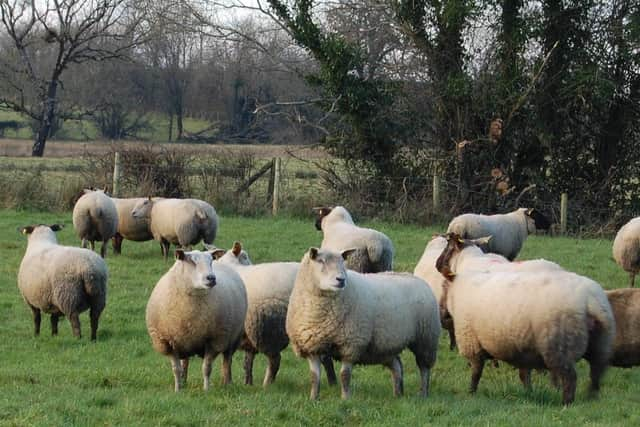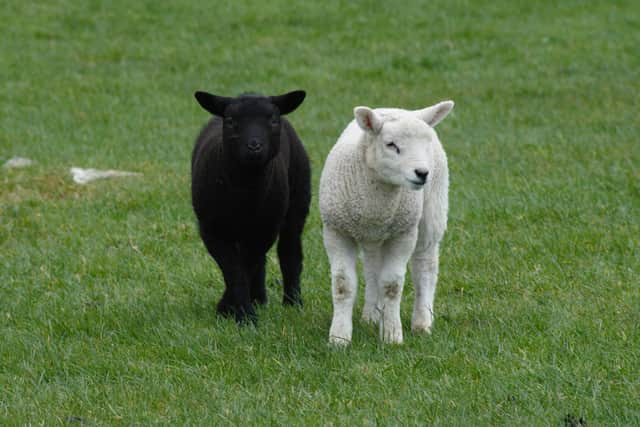It’s steady as she goes for the sheep sector in 2024
and live on Freeview channel 276
In many ways sheep production represents the forgotten sector of agriculture in Northern Ireland.
Yet output from the sector continues to make a vitally important contribution to the food sector and the rural economy as a whole.
Sheep tick all the boxes.


Advertisement
Advertisement
Management systems tend to be quite extensive in nature, making them good for the environment; ewes thrive where cows cannot and, of course, sheep production systems fit well within a part-time farming model.
So much for the background: adding real impetus to the fortunes of the industry at the present time is the fact that flockowners, right across Northern Ireland, are confirming excellent lamb performance rates at the present time.
It’s a very simple equation: the more lambs available for sale, the greater the likelihood of making a profit.
The core issue then becomes one of keeping all these extra animals alive.


Advertisement
Advertisement
The good news here is that farmers have full control of the factors that will allow them meet this challenge.
Either they have the management qualities to make this work for them or they don’t.
No cursing the state of international markets comes into play when it comes to honing one’s sheep husbandry skills.
Adding an extra bounce in the step of local flockowners is their continuing and direct access to the European market.
Advertisement
Advertisement
Approximately, half a million lambs are exported live from Northern Ireland to the Republic annually.
In addition, a significant proportion of our lamb meat exports are destined for the Euro zone with France the number one market in this context.
Admittedly, the sheep industry has had its ups and downs to contend with in the past.
For example, it is the sector that is most vulnerable to the weather.
Advertisement
Advertisement
Most of us well remember the carnage caused by the heavy snows of March 2013 and the heavy lamb losses that ensued.
And, let’s be honest, March of this wasn’t much of a picnic for young lambs either.
Wool is another facet of sheep production that has so much potential for the future. Talk of closer working relations across the island gives great hope for the future, specifically where wool is concerned.
However, if all goes according to plan, let’s that local sheep producers have a decent enough year to look back on, come the end of 2024.
Advertisement
Advertisement
As with other sectors, the weather over the months ahead will have lot to do with it.
But let’s be honest, agriculture in Northern Ireland could do with a few good stories to relate over the coming months.
Wool gets a boost
The New Year has brought with a much needed boost for the wool sector.
Ulster Wool has announced its first sustained price recovery since the pandemic, with a general rise of 20% across recent auctions.
Advertisement
Advertisement
Sold globally across several different markets and products, demand is growing across the world, helped by the addition of three new buyers of scale at Ulster Wool partners, British Wool auctions.
Graham Clark, Director of Marketing, explained: “Over the past few months we have seen a healthy improvement in both demand and prices at our auctions. Generally, prices have increased by 20 percent with some of the more sought-after types gaining 15p to 20p per kilo.
“Our auctions are more competitive than they have been in years with several new buyers entering the fray over the last couple of years. This, along with our promotional work, has had a positive impact on prices and means there is now genuine competition on all wool types.”
Over the past 12 months, Ulster Wool’s partner, British Wool, has further strengthened its brand licensing scheme with an additional 44 brands coming on board. Now, the organisation works with 130 brands across the globe which all use high proportions of British and Northern Ireland wool in their products, further helping to drive new demand.
Advertisement
Advertisement
“Retail sales and consumer confidence very much remain an issue in the UK, we have seen improvements across other markets such as contract carpet plus good volume coming out of China,” Graham Clark further explained.
“Although we are still some way off where we need to be, these gains are very encouraging, and will help support member returns this year.
"We hope to see this trend continue into 2024.”
Wool prices have been strengthened by a growing demand for top quality woollen carpets in hotels, casinos and cruise lines.
Woollen carpets are renowned for being particularly hard wearing.
Advertisement
Advertisement
However, this is an international market, which had languished in the doldrums during the entire period of the Covid pandemic.
However, this trend has been reversed over the past 12 months.
British Wool has been working closely with UK carpet manufacturers to ensure these businesses include the maximum amount of locally produced wool in their products.
Meanwhile, in the UK and Ireland, there is also a strong and growing demand for woollen garments. There are also key indicators points to the natural properties of wool becoming a strong selling point for the product.
Advertisement
Advertisement
Woollen carpets can be fully recycled, once they reach the end of their life cycle. This is not the case for carpets containing man- made fibres, including nylon.
It’s election time
The last week has been confirmed that an election will be held to select Northern Ireland’s regional representative on the board of British Wool, effective from 01 April this year onwards.
The successful candidate will represent Northern Ireland on the British Wool board for a three-year period.
The names of the election candidates that have been nominated are: Brendan Kelly, from Randalstown in Co Antrim; Robert Burgess, from Saintfield in Co Down and Timothy Smith, from Banbridge in Co Down
Advertisement
Advertisement
The current representative from Northern Ireland on the board of British Wool is Brendan Kelly. His term-of-office concludes on 31 March. He holds the position of British Wool vice chairman.
Voting details will be sent to all registered Ulster Wool members on Thursday 18th January 2024.
All votes must be placed by 6pm on Thursday 8th February 2024. Voting papers must also be received by this deadline.
It is envisaged the election process will be very much centred on the use of IT technologies. A combination of email addresses and mobile telephone numbers will be used to communicate with the 3,500 wool producers who would be registered in an election, if it were to be held.
Advertisement
Advertisement
However, all other relevant farmers will be contacted through the mail. It has also been confirmed that producers can cast their vote electronically and through the post.
Civica Election Services (CES) is administering the nomination process for the Board Member Elections in 2024 on behalf of Ulster Wool. Voting in this election will either be online or a hard copy voting paper depending on the communication preferences held on the Ulster Wool database. Should you require any assistance regarding the voting process, please contact CES by emailing: [email protected] or calling: +44 (0) 208 889 9203.
Future support for the sheep sector
It is disappointing to note that the sheep sector is not referenced in any detailed manner within the post-Brexit farm support reforms within Northern Ireland. In principle, funding will be made available to make this happen at some stage on the future. The challange remains that of identifying a technical way forward, where these matters are concerned.
Meanwhile, there seems to be no grey areas at all, where support for the sheep sector in the Republic of Ireland is concerned.
Advertisement
Advertisement
The introduction of a Sheep Improvement Scheme has been well received by farmers. The measure provides financial support to farmers for taking extra steps to improve the welfare of their flock. Farmers get a payment per breeding ewe for completing specific flock welfare measures.
But in addition, recent months have seen a decision taken the Irish agriculture minister, Charlie McConalogue, to push ahead with an Organic Farming Scheme.
Basically, Ireland has committed to have 7% of its agricultural land managed on an organic basis within the next decade. And it’s sheep producers, for the most part, who seem to be grasping this opportunity.
Driving all of this is the very attractive support available during the period of conversion to full organic status. And, of course, the premium lamb prices that can be secured will also kick-in, once full organic status has been achieved.
Advertisement
Advertisement
Given these developments, there is no reason why Northern Ireland could not push for its own organic sheep scheme.
Such a measure would provide a real boost to the sector.
And, of course, let’s not forget that many local sheep units are already managed on a ‘pseudo organic’ basis.
This is due to the fact that very little chemical fertiliser is used on these farms and the need to use agrochemicals comes well down the list of priorities.
Performance recording of sheep: a 50 year milestone has been reached
Advertisement
Advertisement
Last year marked 50 years of the Agricultural and Horticultural Development Board (AHDB) Signet programme in the UK, a period of time that has seen a revolution in the science associated with the performance recording of sheep.
The good news is that the rate of genetic gain within the sheep sector is now increasing at an exponential rate. And this is tremendous news for commercial and pedigree flock owners in equal measure.
It is now possible to breed for numerous traits that are performance recorded. These include ewe longevity and the ability of a ewe to rear her lambs.
Lamb growth rates remain a critically important trait to assess within all sheep enterprises.
Advertisement
Advertisement
Where sheep are concerned, the generational interval is quite small. Hence the potential to drive genetic progress that much faster.
However, the larger the population of sheep under assessment, the faster rate of genetic gain that can be achieved.
Genetic evaluations can also play a key role in tackling the challenge of parasite resistance within sheep flocks are concerned.
Significantly, research has identified genetic differences between sheep in the strength of their acquired resistance to internal worm parasites.
Advertisement
Advertisement
If these differences can be identified by measurements in sheep, this trait can be incorporated into genetic evaluations and improved through selective breeding.
Ongoing genetic assessment will also allow farmers to identify sheep with a low carbon footprint.
July of this year saw the sheep sector in England awarded £2.9M by the Department of Agriculture, Environment and Rural Affairs (DEFRA) in order to specifically identify animals with a low carbon footprint.
This work will constitute a three-year initiative. The project has been christened: “Breed for CH4nge”.
Advertisement
Advertisement
It will measure methane emissions from a total of 13,500 sheep in 45 flocks, collect the necessary data and build and develop the tools required to genetically reduce methane emissions and improve the efficiency of the national flock.
The initiative should eventually demonstrate the impact of low-carbon sheep on whole farm carbon footprints.
In conclusion
So as 2024 stretches out before us, there is plenty for sheep farmers in Northern Ireland to look forward to.
The role of the sector in providing a sustainable backbone to the grass based sectors is undeniable. What’s more, this is an advantage that can be successfully built upon for the future.